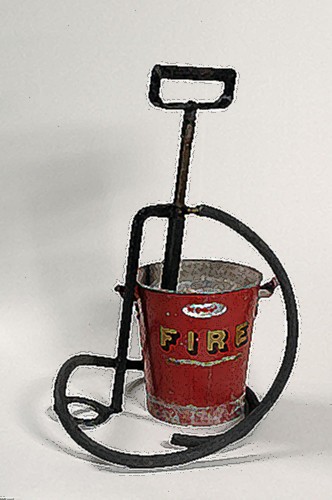


1940 Stirrup Pump Hendon
English Translation
 |
Historique Voir ICI
History Click HERE
Les pompes à étrier ont été utilisés par les Fire Guards pour éteindre les bombes incendiaires larguées par les avions ennemis pour provoquer des incendies et des perturbations (autrement connu comme 'Firebomb Fritz'.
Dans la nuit du Dimanche 29 Décembre 1940, la ville de Londres a été dévastée par les bombes incendiaires. Bureaux et bâtiments avaient été fermés pour le week-end et laissés sans surveillance. Cela a rendu plus difficile l'intervention des services d'incendie et de sauvetage.
Aussi il a été créé un service de vigies à partir de Janvier 1941 avec la présence obligatoire d'une personne 24 heures/24 dans les «zones réglementées» afin de pouvoir intervenir rapidement Mais comme cela s'est avéré difficile pour de nombreux établissements il a été déccidé de mettre en place un service de vigie obligatoire en Août 1941. Les hommes et les femmes entre les âges de 16-30 et 20-45 sont respectivement susceptibles d'être appelé pour le service d'incendie. Les volontaires peuvent uassi y participer ( les hommes jusqu'à 70 et les femmes à l'âge de 60 ans.
Mais cette garde est un travail fastidieux et il devint rapidement impopulaire. Car les ouvriers devaient passer des nuits entières à surveiller Les ouvriers devaient en plus de leur travail assurrer cette garde
This Stirrup Pump was found in a Glasgow Market, the Barras in the 1990's. Stirrup Pumps were used by Fire Guards to put out Incendiary bombs dropped by enemy planes to cause fires and disruption (otherwise known as 'Firebomb Fritz'.
On the night of Sunday 29 December 1940 the City of London was devastated by incendiary bombs. Offices and buildings had been locked up over the weekend and were left unattended. This made it more difficult for the fire and rescue services.
As a result a fire watchers' scheme began in January 1941. It was made compulsory to have person(s) on guard in buildings twenty-four hours (in “prescribed areas”), to put out incendiary bombss and to call for help. This proved difficult for many establishments to staff. This lead the Government to implement a compulsory scheme of fire watching.
Fire watching teams were originally called street fire parties they adopted their official title of Fire Guards in August 1941. Men and women between the ages of 16-30 and 20-45 respectively were likely to be called up for fire duty. Volunteers were encouraged from men up to 70 and women to the age of 60.
Fire watching was a tedious job, watching business premises and factories was unpopular. Fire Guards undertaking the latter were likely to spend whole nights fire watching. Street watchers differed in the sense that nightly duties were shorter. Workers would often have to watch in the early hours of the morning return home and then get up to undertake a long shift in a war factory, starting at 6 a.m.
The Need for the Fire Guard
‘Britain’s Fire Guard has been formed as an essential factor in the defence of this country against the attempts of the enemy to destroy its industries and to win the war by fire. Fire bomb raids are a threat to the very life of the nation. As is well known a very small number of bomber aeroplanes can shower many thousands of small incendiary bombs over a town in the space of a few minutes; and these, if left alone, will start more fires than could possibly be put out either by the National Fire Service or by the efforts of unauthorised and untrained individuals, however well meaning they may be. This is why it becomes the duty of all able bodies men and women to give whatever service they can in the part-time army of millions of citizens trained to deal with fire bombs promptly whenever and wherever they fall’.
The Duty of a Fire Guard
‘The duty of a Fire Guard is to take turns in watching for the fall of fire bombs; to warn the neighbourhood when they fall in the area for which he is responsible; to help promptly to control them and thus to prevent small fires from becoming big fires; and to fit himself by training to perform the work efficiently.
It is work which sometimes requires courage and endurance; it involves the sacrifice of time that can sometimes be ill spared, and often entails a great deal of tedious waiting and watching; but it is work which must be done if the homes and industries of the Nation are to be saved .......’
Extracts taken from: Air Raid Precautions handbook no.14, 1st ed. The Fire Guard’s handbook. HMSO. 1942.